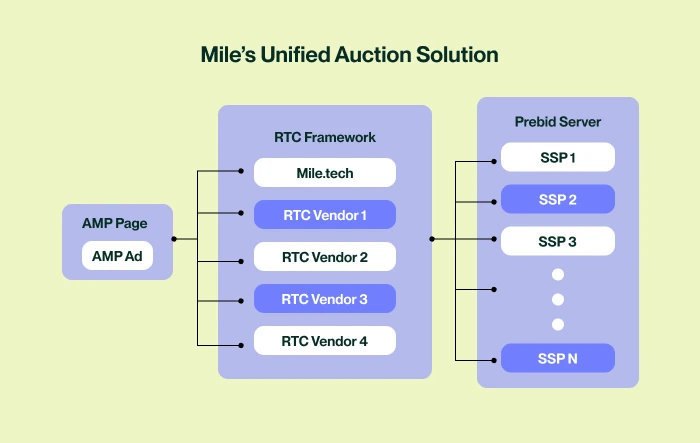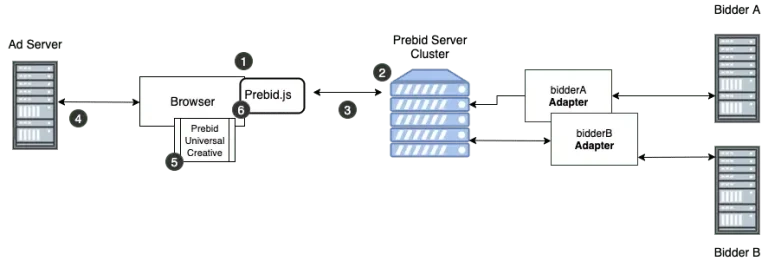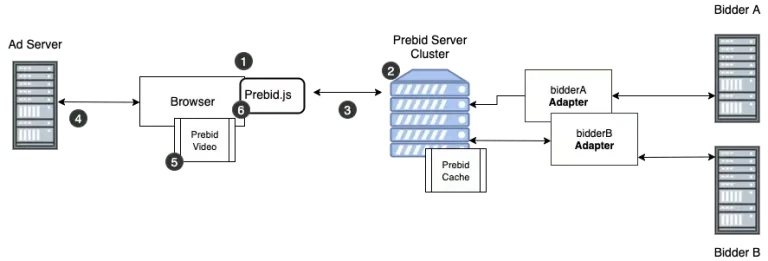Prebid Server: Understanding Prebid’s Server-side Header Bidding




Prebid Server reduces latency, improves scalability, and provides more control in header bidding compared to client-side setups.
Server-side header bidding is key to reducing latency and improving scalability in programmatic advertising. While Google’s Open Bidding and Amazon’s UAM offer proprietary solutions, they often lack transparency and control.
Prebid Server, an open-source alternative, addresses these issues with transparency, flexibility for custom setups, and community-driven improvements. However, it comes with challenges like complex implementation and potential reliance on third-party providers, which may limit visibility and introduce data inconsistencies.
In this article, let’s understand it all.
Prebid Server offers publishers a powerful solution to scale demand and improve programmatic performance, addressing key challenges in modern advertising setups. Its ability to seamlessly integrate multiple SSPs (Supply-Side Platforms) without being limited by latency is a major advantage, enabling up to 40% latency improvements compared to client-side configurations.
In a client-side setup, the browser manages auctions and sends multiple requests to the ad server, increasing latency. A server-side setup, by contrast, requires only a single request, shifting the auction process to the server, where it’s faster and more efficient. For publishers aiming to enhance both scalability and performance, Prebid Server is an ideal choice.

Prebid Server also excels in monetizing AMP (Accelerated Mobile Pages), which rely on the RTC (Real-Time Config) framework. This framework imposes strict limitations on header bidding, such as restricting requests to five and enforcing short 1000ms timeouts. Prebid Server overcomes these constraints with unified auctions and its ability to send requests to as many demand partners as needed. Its server infrastructure is significantly more robust than a browser, ensuring fast auctions without timeouts, unlocking greater revenue potential for publishers monetizing AMP pages.
Recent enhancements to Prebid Server have further solidified its position as a go-to solution for publishers:
With these capabilities and updates, Prebid Server empowers publishers to overcome latency, scalability, and privacy challenges while maximizing revenue potential.
Here’s an overview of how Prebid Server works for banner and video ads:


When implementing a Prebid Server, you have two primary options:
Consider the following table to weigh the pros and cons of each approach:
Prebid Server is designed to comply with major privacy regulations:
Recent Prebid 9.X updates as well bring significant advancements in user privacy control and data management, empowering publishers to navigate the evolving privacy needs. Here's a breakdown of the key updates:
Because server-side header bidding involves multiple platforms communicating through a centralized server, discrepancies in impressions or revenue can be higher compared to simpler setups. A strong, well-optimized server infrastructure is essential to minimize these gaps.
With a managed Prebid Server like Mile, the infrastructure and data flows are already optimized for minimal discrepancy, so publishers don’t need to handle any of this internally.
Troubleshooting a Prebid Server setup can be more complex. This comes partly from the open-source nature of Prebid and partly from the fact that most issues occur server-side rather than in the browser. This can make the debugging process time-consuming without the right expertise.
Mile simplifies this by handling Prebid Server maintenance, monitoring, debugging, and updates for you, ensuring issues are resolved quickly without draining your internal resources.
Server-side auctions require dedicated infrastructure. Building, scaling, and maintaining your own Prebid Server can be costly if done in-house, especially when factoring in uptime guarantees, monitoring, security, and DevOps resources.
A managed Prebid Server like Mile removes this burden entirely, you get enterprise-level infrastructure without the overhead of running your own servers.
Server-side header bidding naturally has lower cookie match rates because syncing IDs is more complex outside the browser. Lower match rates mean buyers may have less data available, which can sometimes lead to more conservative bids.Mile’s Prebid Server improves this with enhanced ID modules, better bidder connectivity, and optimized match workflows to maintain stronger match rates and protect publisher CPMs.
To optimize Prebid Server for peak performance, strategically allocate demand partners, prioritize top performers on the client-side based on response time, bid rate, and win rate, while channeling slower-responding partners to the server-side.
Expand the bidder pool by integrating non-Prebid demand sources like Amazon's UAM and Google's Open Bidding. Also, for AMP pages, leverage Prebid Server to maximize revenue while adhering to strict performance benchmarks.
Consider a hybrid approach to balance latency and revenue to maintain top performers on the client-side while migrating others to the server-side.
To further refine your setup, implement dynamic timeout adjustment and AI-powered floor pricing to optimize auctions and maximize ad revenue. Finally, leverage modular frameworks to integrate specific plugins or modules, unlocking advanced header bidding features for enhanced revenue and user experience.
Remember that optimization is an ongoing process. Regularly monitor performance metrics to identify areas for improvement. By continuously analyzing your setup, you can ensure that both ad revenue and user experience remain consistently exceptional.
Prebid Server is the server-side version of Prebid that runs header bidding auctions on a backend server instead of the browser. The page sends a single request to the Prebid Server, which runs unified auctions, processes bids, caches video creatives when needed, and returns targeting information for the ad server.
Prebid.js runs auctions in the user’s browser, generating multiple network calls and adding latency. Prebid Server moves those auctions to a server, reducing browser load and enabling more SSPs, larger auctions, and better scalability—especially for AMP and mobile traffic.
Prebid Server is ideal for publishers needing lower latency, AMP monetization, large bidder pools, or enterprise-scale auctions. It’s also suited for setups requiring advanced privacy compliance, unified auctions, or integration with server-side partners such as Amazon UAM or Google Open Bidding.
Prebid Server supports a wide and growing list of SSPs, with new adapters added regularly (e.g., Nativo in v3.x). Publishers can integrate multiple SSPs through Prebid Server directly or through a partner like Mile, which manages connectivity, bidder onboarding, and server-side optimization.

